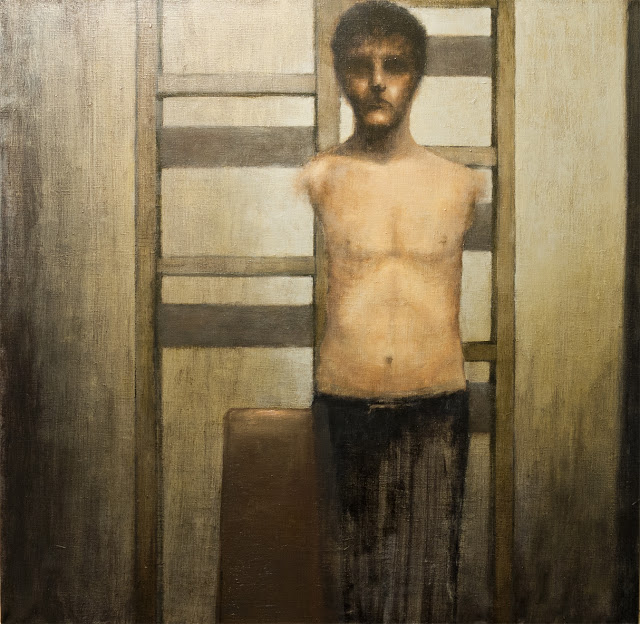September 30, 2014 - 19:24

In my search for a portrait featuring a visibly disabled subject, I came across this painting, by the artist Paul Fiore. I was particularly interested in this piece because it appears on Fiore’s blog with little information, other than the title “Amputee” and an explanation that he has not yet completed it. I hoped that a close reading of an unfinished product (particularly one painted by a man who, as far as I can tell from my research, does not have a visible disability) might give me some clues as to how Fiore intends to continue work on his painting.
The most noticeable aspect of this portrait to me is the placement of shadow. While portraits in general often try to highlight a face to bring humanity to a body, and while this seems to be particularly true with portraits of the visibly disabled (in an attempt to restore humanity that is often lost in others’ perceptions of the disabled), Fiore has left the subject’s face almost entirely in shadow. His pants are black, and fade into the bottom of the image. In fact, the part of the subject’s body that is the brightest and most noticeable is his torso, where his two arms have been amputated. Interestingly, the two shoulders are slightly blurry, as though conveying some sense of incompleteness (either due to the fact that the artist has not actually completed the painting or because there is an attempt to make an [offensive] statement with the subject’s lost limbs—he is in some way “incomplete”). The shadow created by his head onto his collarbone is cut off sharply, and his head is slightly off-center of his otherwise very symmetrical body, as though suggesting that either the head or the torso is not really his.
The portrait is framed on the left and right sides and the bottom with black, which draws the viewer’s attention even more immediately to the subject’s body, which is quite dramatically the brightest part of the image. This is the case even though the man in the portrait is slightly off-center. The subject is standing completely upright, which would normally create a sense of confidence; here, this is contradicted by the shadowed, solemn face. It is as though the artist is attempting to highlight the visibly disabled aspect of the man’s body to show the subject’s scorn about what has happened to him.
The background of the portrait is simple but very contradictory to the subject. The image appears to feature two ladders, connected or at least right next to each other, and a large brown rectangle (which I had assumed upon first sight to be a suitcase). These choices are interesting, because they are both items that assume arm function; an individual would typically need functioning arms and hands to climb the ladder, as well as to lift the suitcase. The suitcase seems to be positioned slightly behind the subject, as though the subject is directly conveying a message to the viewer about the suitcase. Because the subject seems to be looking straight forward (though of course we can only assume this because his eyes are completely in shadow), it does seem that he is attempting to convey some message to the audience.
I am not clear on the medium the artist has used besides that it is some form of paint that appears to be laid out on a canvas of sorts (looking closely, the lines of a tight cloth are visible). Fiore utilizes black, brown, and varying shades of tan as his primary colors, furthering this sense of melancholy we get from the subject’s frowning, shadowed face. The subject’s bare skin is pale, except for his shadowed face, and he appears to be fairly thin (once again contributing to the sense of melancholy).
Looking at this portrait without evidence (despite research) that Fiore himself is disabled or has any sort of history portraying the visibly disabled, I have to wonder whether the image is meant to be some sort of commentary on the way our culture is so quick to focus on the visibly disabled part of the individual, or whether it is not meant to send a message at all (which to me seems more likely).

